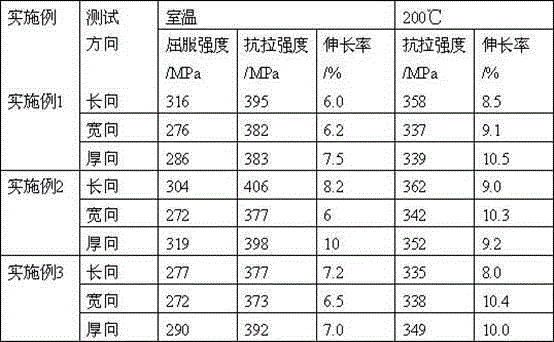Forging forming process of a large-size high-strength heat-resistant magnesium alloy thick plate
A forming process and technology of magnesium alloys, which are applied in the deformation processing of magnesium alloys and the field of forging deformation of Mg-RE alloys, can solve the problems of increased deformation processing, narrow deformation temperature range, and large deformation resistance of rare earth magnesium alloys, and achieve defects. Less, less component segregation effect
- Summary
- Abstract
- Description
- Claims
- Application Information
AI Technical Summary
Problems solved by technology
Method used
Image
Examples
Embodiment 1
[0013] Example 1: Mg-8Gd-3Y-0.6Zr (wt.%) alloy ingots with a diameter of Ф200mm and a length of 480mm were machined into a semi-continuous casting process by melting raw materials in a large furnace, and the ingots were homogenized and annealed. Heat the ingot at 520°C for 4 hours, perform upsetting and drawing forging on the hydraulic press, the reduction speed is 200-400mm / min, the reduction of the upsetting pass is 30-50%, and the reduction of the elongation pass is 5-10% . When the billet temperature is lower than 430°C, it is returned to the furnace for annealing, the annealing temperature is 510°C, and the holding time is 2h. After annealing, the upsetting process is repeated, and the ingot is forged into a billet of near-final size after three times of upsetting and drawing. The billet reserves 10-15% deformation in the height direction and width direction for the low temperature rapid forging process. After the billet was kept at 500°C for 2 hours, it was quickly for...
Embodiment 2
[0014] Example 2: Firstly, a large melting furnace was used to melt raw materials, and after semi-continuous casting, a Mg-9Gd-4Y-0.6Zr (wt.%) alloy ingot with a diameter of Ф300 mm and a length of 400 mm was machined, and the ingot was homogenized and annealed deal with. After 6 hours of heat preservation at 530°C, perform upsetting forging on a hydraulic press, with a reduction speed of 200-400mm / min, a reduction of 30-50% for upsetting passes, and a reduction of 5-10% for elongating passes. When the surface temperature of the billet is lower than 430°C, it is returned to the furnace for annealing, the annealing temperature is 510°C, and the holding time is 2h. Repeat the upsetting and drawing process after annealing, and forge the ingot into a billet after three times of upsetting and drawing. The billet reserves 10-15% deformation in the height and width directions for the low-temperature rapid forging process. After the billet is kept at 480°C for 4 hours, it is quickly...
Embodiment 3
[0016] Example 3: Using a large melting furnace to melt raw materials, semi-continuous casting, machining a Mg-9Gd-2Y-0.6Zr (wt.%) alloy ingot with a diameter of Ф300mm and a length of 500mm, and performing homogenization annealing on the ingot. After 8 hours of heat preservation at 500°C, perform upsetting and drawing forging on a hydraulic press, with a reduction speed of 200-400mm / min, a reduction of 30-50% for upsetting passes, and a reduction of 5-10% for elongating passes. When the surface temperature of the ingot is lower than 430°C, the annealing temperature is 490°C, and the holding time is 4 hours. The annealing temperature is 10°C lower than the previous annealing temperature. Repeat the upsetting and drawing process after annealing, and forge the ingot into a billet after three times of upsetting and drawing. The billet reserves 10-15% deformation in the height and width directions for the low-temperature rapid forging process. After the billet is kept at 490°C fo...
PUM
 Login to View More
Login to View More Abstract
Description
Claims
Application Information
 Login to View More
Login to View More - R&D
- Intellectual Property
- Life Sciences
- Materials
- Tech Scout
- Unparalleled Data Quality
- Higher Quality Content
- 60% Fewer Hallucinations
Browse by: Latest US Patents, China's latest patents, Technical Efficacy Thesaurus, Application Domain, Technology Topic, Popular Technical Reports.
© 2025 PatSnap. All rights reserved.Legal|Privacy policy|Modern Slavery Act Transparency Statement|Sitemap|About US| Contact US: help@patsnap.com

